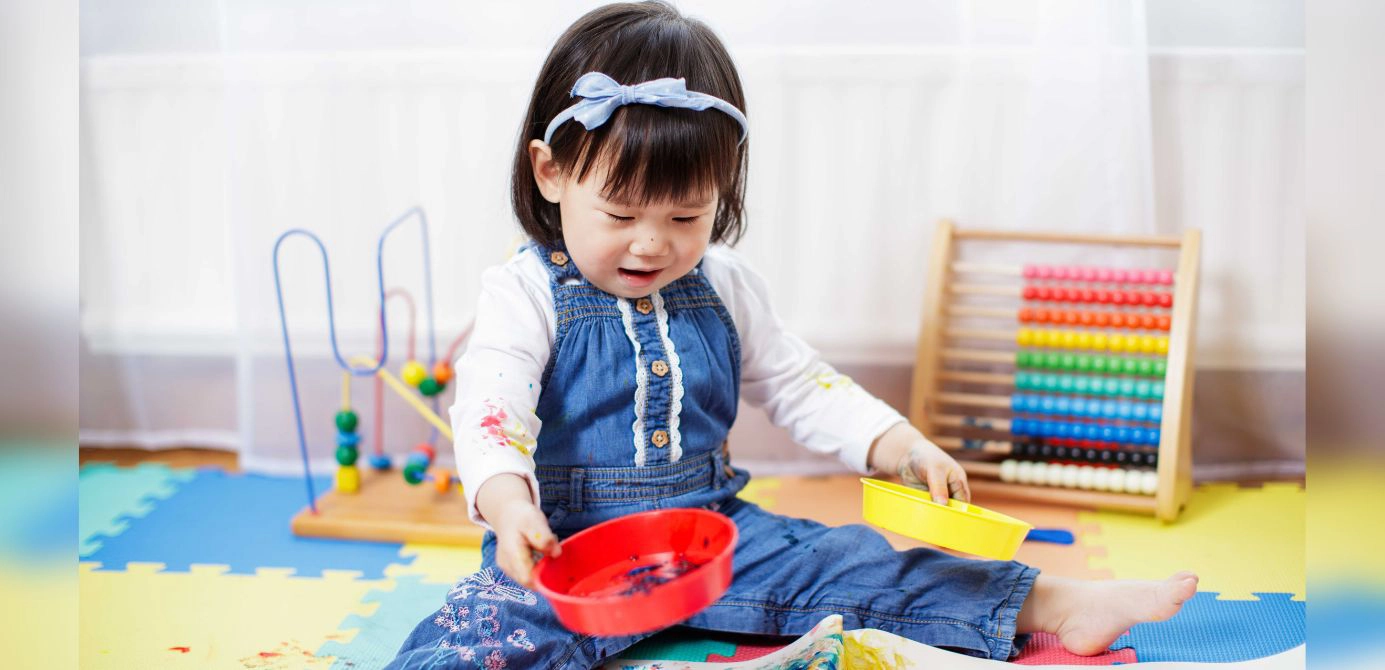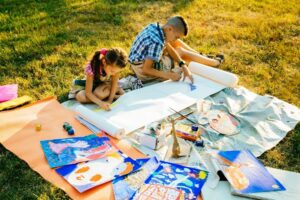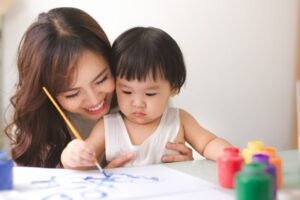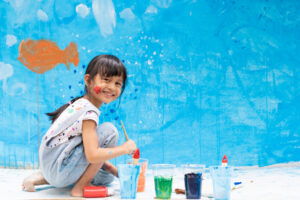Aims & Objectives Of Art Activities For Preschoolers
![]()

Art is a natural way of learning about the world. It is among the most effective approach for toddlers to learn to communicate and think for themselves. Art activities for preschoolers also provide very young children with the opportunity to create, share, and convey meaning, using non-verbal ways.
Art is playtime for children. Art lessons for kids never put them under pressure, they feel comfortable and have fun as they soon realize that art is also a very pleasurable experience. Indulging in art activities for preschoolers allows children more opportunities for self-expression and being involved in creating freely results in greater creativity, as children find that they are free to express even their innermost thoughts.
Object based art stimulates the senses. Toddlers get to explore texture, shape, colours, light and shade and structural forms. Early Art lessons for kids at home enable them to express what they know and understand about the environment they live in using paint, clay, crayons, and finger painting.
Children are inventive people, and they discover that creative art activities for preschoolers help them to express who they are, and is an easier way to process and integrate their perceptions about the life they experience.
Impact of Art Objectives For Preschoolers
How art benefits toddlers

Just think about what happens when you hand over some finger paint and a blank sheet of paper to your toddler. As your child’s tiny hands begin to experiment with mixing colours, and creating swirls on the page, she is excited and feels engaged. An additional benefit is that your child will be developing and improving her hand-eye coordination exercises on a daily basis.
By learning to hold a crayon in her hand, your toddler may just begin to draw a house and trees, and birds. Flexing important muscles in her arms and fingers to develop her fine motor skills. Working with her hands and practising repetitive motions and art activities for kids such as picking up objects helps refine her pincer grasp, and improves focus and discipline.
Art lessons for kids give young children a sense of spatial orientation – this is a cognitive skill that helps with flexibility, dexterity and more. For instance, carrying art materials and cleaning up after a session helps in gross motor transferring skills, making decisions and learning from mistakes. More importantly, by diving deeper into her imagination, your child will be able to exercise her mind and gain a sense of independence when she creates something of her very own.
Always encourage your child to participate in any kind of art activities for kids, even if your little one isn’t ready to do much yet. Just keep at it, and encourage your toddler to speak her mind and to tell you, in her own words, what she is thinking and planning as she makes decisions. Which of the colours she plans on using, what to put where. This facilitates rapid verbal development and sentence formation capabilities.
The best thing is that art school activities give little ones a sense of accomplishment, boost their self-esteem, create opportunities and accelerate social and emotional development processes. Gaining confidence and feeling good about oneself is important for toddlers, so patience, praise and a positive attitude go a long way in ensuring art therapy activities end up having the desired effect. [ Source ]
Keep your toddler’s art projects simple

Early years should be all about providing toddlers with a solid foundation, establishing the building blocks of language development through art processes which allow them to become confident, lifelong learners. Introducing age-appropriate art projects should be your aim, as this is an effective way for young learners to engage and stay actively involved.
Ensure all art-inspired kids activities are simple and have easy-to-follow steps, this helps your toddler focus on activities that aren’t above her developmental level. Above all else, make sure your toddler’s art projects are fun to do as well. Introducing complex art projects at this age may just cause frustration, put her off, and lose interest.
Using beads or buttons helps your child with counting skills while glueing objects together or colouring by numbers can help colour selection, and improve vocabulary. Also, make sure you keep a close watch while your toddler is busy engrossed with these tasks. Staying alert will give you enough time to prevent your toddler from hurting herself when a task involves cutting, or prevent her from accidentally swallowing a bead when she is threading them.
Embark on a journey of growth together!

Art lesson objectives help to spark your child’s natural curiosity and create her own journey of exploration, discovery and development. What’s more, opting for art activities at an early age is a very engrossing cognitive skills development process and at the same time is great fun for your child!
Toddlers love object-based art therapy activities and are especially helpful when you don’t want your child to spend all her time in front of the TV. So roll up your sleeves and get down to getting involved with your child and engage her in art activities.
For toddlers, making art is a sensory exploration activity. They enjoy the feeling of a crayon moving across the paper and enjoy seeing a blob of coloured paint grow larger or dissolve, and are amazed when they see for themselves what happens when they mix one colour with another and a new colour emerges like magic!
Exploring art materials plays a critical role because only through exploration toddlers can build knowledge of the objects in the world around them. Kids activities centring around making art also helps young children to make decisions and conduct self-evaluations.
As your toddler grows and develops, her art education will move beyond exploration through their senses and begin to involve the use of symbols. Your child will use symbols to represent real objects, events, and feelings in her artwork.
Drawing can take on a lead role as a means of expression as it enables your toddler to symbolize feelings. It indeed becomes an effective outlet for very young children whose vocabulary is limited. This practice of using symbols in the artwork is very important because it lays the foundation for a child’s later use of words to symbolize objects and actions when she begins to write.
Finally, art activities for preschoolers enable adults and children to learn together and involve explicit and positive learning outcomes. It inspires young children to aim higher, and gives them the resources they need to change their lives for the better.
Parents are central in helping their children find out how they can improve upon their creativity. By sharing their work with an adult, they can celebrate their achievement, and feel valued and recognised. This, in turn, builds self-esteem in children in the years to come.
About Abrakadoodle
Process Art learning experiences inspire toddlers and young children to think different, be innovative, and devise ways to learn about interesting things found in the real world. Changing the way a child discovers and imagines. Igniting her mind to think, play and learn like never before.
If you like to enrol your child in our children’s art classes or participate in cognitive learning activities, give Abrakadoodle a call. Or better still, make an appointment with the head of a centre near you.
Get hands-on exposure to an experience that will make you see art in a way that adds value to your child’s life.
Please note: Abrakadoodle classrooms are thoroughly sanitized every day — the tables, the chairs, the children’s activity stations and everything else the child might touch is made safe and clean. They also wear a mask, wash their hands frequently, and practice social distancing.
Frequently Asked Questions
What are the aims and objectives of teaching art?
The following are the objectives of teaching art:
1. Art lessons assist in flexing muscles and developing motor skills.
2. It helps children understand spatial orientation better.
3. It promotes critical-thinking abilities.
4. It boosts self-esteem and confidence.
5. It boosts a child’s vocabulary and linguistic abilities.
What is the importance of art for child development?
The importance of art in early childhood:
1. Enriching activities are geared toward strengthening fine motor skills.
2. Process art activities allow children to explore and experiment with new concepts.
3. An excellent method for enhancing sensory stimulations.
4. Arts and crafts encourage social interaction.
5. Children learn to express themselves creatively and become aware of their emotions through therapeutic art activities.
How to teach art to preschoolers?
Exciting ways to pique your preschooler’s interest in art lessons include:
1. Color mixing techniques are simple to experiment with.
2. Drawing improves self-expression.
3. Canvas painting encourages children to explore art materials with their senses.
4. Among the simple early art lessons for kids at home is the preparation of homemade paints.
5. Finger painting allows children to learn about different textures while also flexing their muscles.
What should I teach my child in art class?
The curriculum of an art class primarily focuses on the following creative art activities for preschoolers:
1. Canvas painting
2. Doodling
3. Water-colour painting
4. Sketching
5. Finger painting
How do you teach the process of art?
Since the process of art creation is relatively flexible and allows children to experiment and explore new lessons, it is critical to guide children through the fundamentals of the process in order to stimulate their cognitive skills and inspire them to express their ideas through art. Thus, through process art activities, art school activities help children harness their innate potential.
![]()



